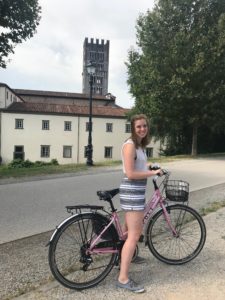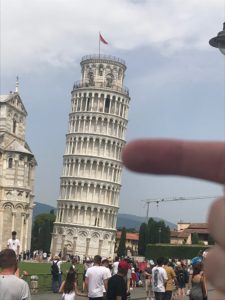
The Palio. The reason for the season. The culmination of weeks of preparation, bribery, collusion, and dumb luck. The 700-year-old tradition that only comes around twice every year and gives Sienese citizens an excuse to drink more wine than should be possible, brawl with their neighbors, and spend hundreds of Euro to sit in the blazing Tuscan sun for hours. Yes, the Palio is the life force for this small city, and it is daunting for the non-Sienese to understand the meaning behind the four-day event or the best way to become a part of it. Here is my personal guide for how to conquer the Palio.
1. Live in a Contrada with members of the Contrada. This will ensure that you get all the dirt on the other Contrade and have an idea of what is actually going on. Living with Flora, the most passionate member of the Giraffa (Giraffe) Contrada that I have seen so far, has instilled in me a loyalty to the Contrada after only two weeks here, and it also gives me something to root for. I was able to feel the emotion both in the house as the race got closer and in the streets when the citizens made their way to the Campo for the event. A crucial feeling if you want to make the most of your experience.
2. Do your research. This is important. The tradition of the Palio goes back to the 14th century, so there are a lot of customs that just seem weird if you don’t understand why they are happening. There are parades of people in funny costumes, they bring the horses inside their churches, and the cheers are just strange. Luckily for me, my school offered a lecture on the history, customs, and Do’s and Don’t’s of the event. His information was fairly biased, but what do you expect from a member of Torre (Tower), the natural enemy of the Oca (Goose), this year’s favorite. But knowing the general schedule of the festival days eliminated some of the confusion.
3. Go to a Prova, and be sure to get there early. There are six practice runs during the Palio days, so take advantage of this and get a good spot to watch at least one of them. These definitely aren’t as exciting as the actual even, but it gives you a chance to watch enemy Contrade sing/scream at each other and, for children under 10, this is the only opportunity to see the horses run. Not every jockey pushes their horses during the trials, but for the newer horses, these practices are critical for learning the tricky track. If you don’t want to wait in the Campo for an hour or two to get the best spot, try going to a morning Prova, which is generally less crowded, but there is much more sun.
4. Get yourself a ticket to a Contrada dinner in a racing Contrada. The night before the Palio, each Contrada puts on a huge dinner in the streets of the city. While the food isn’t great, there is unlimited wine (so be sure to keep your ears open at the end of the night to find out how the locals actually think their horse is going to do) and the atmosphere is incredible. The captain and jockey of the Contrada give speeches, so, if you understand Italian, you get a glimpse into the values of the Contrada. I ate with the Tartuca (Turtle) Contrada, and the locals were not optimistic. The energy was low and the crowd stayed fairly quiet. but it is still a must.
5. Get an uphill spot. This is important if you actually want to see the horses run. Assuming that you do not have the connections or the Euro to buy a seat in the bleachers encircling the track, you will have to go into the center of the Campo if you want to be at the race in person. This is an incredible experience, but beware. There are definite high points and low points, and if you are stuck in the pit of the Campo, there is no way you will see anything.
6. Listen to the locals. Whether you want to start a conversation with those  around you during your hours long wait or you want to eavesdrop on those around you, the locals who choose to watch from inside the track often have interesting opinions about the race or funny comments about people of their enemy Contrada. They can guide you through the protocol for the parade and race if you can understand their words and body language. Also, the noises of the crowd as a whole are incredible to witness. The actual race isn’t like the practices. No one is singing, and there are times when the entire square goes quiet. Don’t be the one person who starts laughing at that time. Just don’t.
around you during your hours long wait or you want to eavesdrop on those around you, the locals who choose to watch from inside the track often have interesting opinions about the race or funny comments about people of their enemy Contrada. They can guide you through the protocol for the parade and race if you can understand their words and body language. Also, the noises of the crowd as a whole are incredible to witness. The actual race isn’t like the practices. No one is singing, and there are times when the entire square goes quiet. Don’t be the one person who starts laughing at that time. Just don’t.
7. Be ready to wait. First, you have to get to the Campo hours early if you want a good spot and sit in the blazing sun. Next, a parade of the Contrade goes around the track. Very cool, but also very long. Don’t be afraid to sit down during this time for some sweet relief for your poor feet. Finally, the horses come out, but the race doesn’t actually start until the jockeys are done working their deals. the horses will line up, the jockeys will start gabbing, and the horses get so agitated that they have to exit the starting area and begin again. Then there are false starts. But you can’t take your eyes of the starting area lest you miss the start. For reference, it took an hour and a half for the race to start this time around after the jockeys entered the track.
8. Avoid fights. At all costs. Inevitably, one Contrada’s jockey will sabotage another’s. So, naturally, members of the two involved Contrade must engage in a fist fight to get payback for costing the race. Or, the star jockey on the star horse in the best starting position (Oca) will lose and will have to run away to avoid being killed by his own Contrada. So, stay away from that.
9. Put your phone down. This one is simple. Take one picture before the race to see the crowd and show how close you are to the track. Then put it away. The race is filmed by a camera way better than your phone, and it’s not worth the locals making fun of you in the background.
10. Speak Italian as much as possible, and ask locals about it. This is the best way to gauge what to do and who is slated to win. When getting a snack before entering the Campo, I asked the deli worker what Contrada she was part of. She was a member of Tartuca, and not optimistic of her chances. When I told her I lived in Giraffa, she told me about how good our jockey was and how we just had to get Oca out of the way and we were home free. Others in the Campo were explaining what each person in the parade was representing and coaching us through which Contrade were enemies. Very helpful.
Even though the mighty Giraffa fell to Drago (Dragon) this year, my experience with the Palio was incredible. It gave me a glimpse into the lives of a Sienese citizen and gave me an excuse to engage with the locals. Italian conversations at home and at school have gotten much more passionate, and I feel like I have hit my stride. All it took is 4 days of midieval mayhem.

